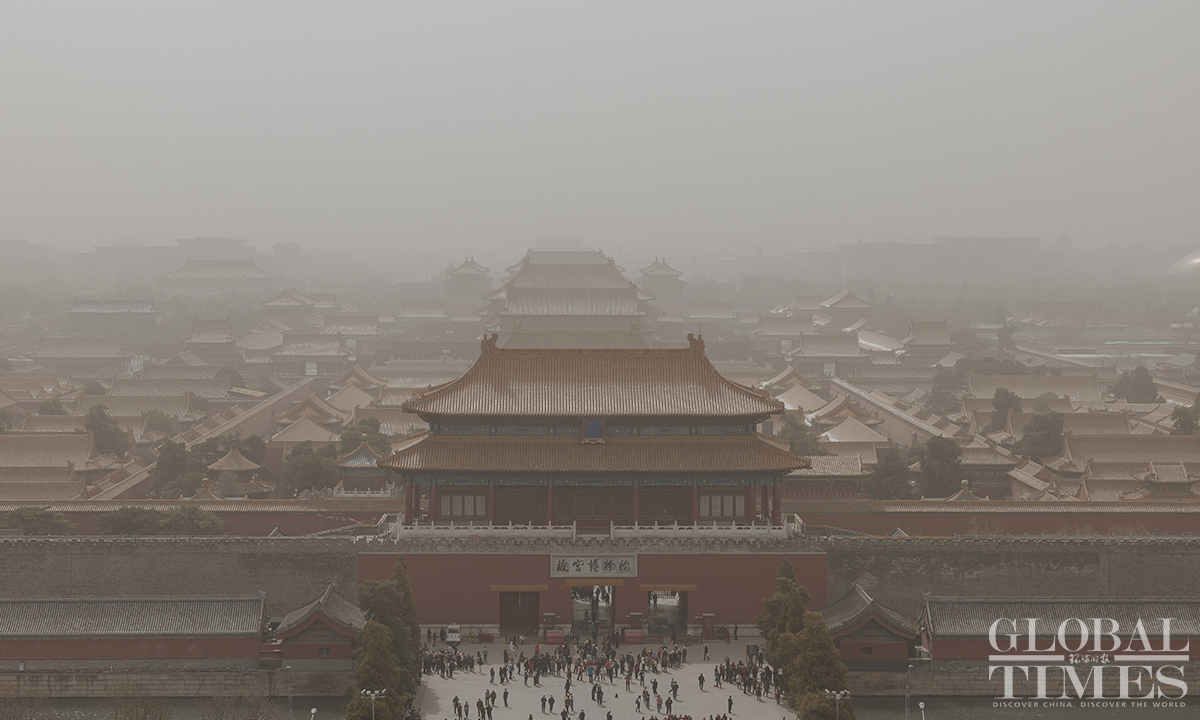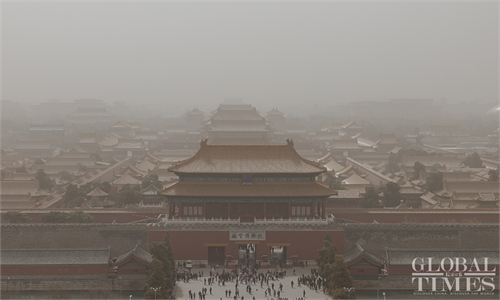Sand and dust weather cause loss of 5.4% good-air days nationwide in 2023: authorities

Beijing reports high pollution levels on March 22, 2023 as the largest sandstorms of 2023 sweep across northern China from March 21, 2023. Photo: Li Hao/GT
Sand and dust weather events so far this year have led to a 5.4 percent loss in the proportion of days with good air quality nationwide, China’s ecology and environment authority revealed, predicting new problems and challenges to the nation’s goal of eliminating polluted weather due to the full recovery of economic and social activities this year.
China has experienced six sand and dust weather events, including four in March since the beginning of this year. The occurrence of sand and dust weather events since March is slightly higher than the same period in previous years, Liu Bingjiang, director of the Department of Atmospheric Environment of China’s Ministry of Ecology and Environment, revealed during a regular press conference on Tuesday.
According to Liu, the strong sandstorm that occurred from March 19 to 23 was the most severe one and had the widest range of impact so far this year, with 20 provinces, autonomous regions and municipalities across the country being affected.
Based on visibility, meteorological departments classify sand and dust weather events into five categories including severe sandstorm, strong sandstorm, sandstorm, blowing sand and floating dust.
Affected by the sand and dust weather events, a total of 140 cities across China have experienced severe or worse levels of pollution so far this year, including 131 cities experiencing severe pollution, the highest number over the past five years, Liu said.
The concentration of PM2.5 and PM10 across the vast lands of northern China reached severe pollution levels with the peak value of PM10 in Zhangjiakou, North China’s Hebei Province, exceeding 9,000 micrograms per cubic meter, according to Liu.
As of March 26, the sand and dust weather events so far this year have led to a loss of 5.4 percentage points in the proportion of days with good air quality nationwide and an increase of 1.2 percentage points in the proportion of heavily polluted days, Liu noted.
“The weather forecast department said that the sand and dust weather events ended on March 24, which was judged by visibility, whereas the impact on air quality has not yet ended, As of yesterday, many places still experienced floating dust, with the PM10 levels remaining above the standard,” Liu said.
Liu said the main reasons for the increase in sand and dust weather this year include the lower precipitation in Mongolia in 2022 which led to poor vegetation coverage in the origin of sand and dust. Besides, relatively higher temperatures in the southern parts of Mongolia and northwestern parts of China in March resulted in rapid melting of the sandy soil in the permafrost layer and extensive surface exposure, which was conducive to sand and dust activities.
The second reason is that meteorological conditions are favorable for sand and dust transmission. The frequent cold air activities in Mongolia this year generated strong winds which stirred up sand and dust, providing favorable meteorological conditions for the uplift of sand and dust particles into the upper atmosphere. A large number of sand and dust particles were transported downstream and deposited, plus the local source of sand and dust in Inner Mongolia, affected the northern parts of China.
The ministry expects the frequency of sand and dust events in northern China this year to be higher than the same period in the past decade.
According to Liu, the meteorological forecast shows that there may be an El Niño phenomenon during this autumn and winter. The activity of cold air in northern China will weaken, which will lead to higher temperatures and an overall unfavorable atmospheric diffusion condition. Moreover, the increase in emissions, which resulted from the full recovery of economic and social activities, will pose new problems and challenges to the goal of eliminating polluted weather.
According to Liu, the goal for 2025 is to basically eliminate heavy pollution days nationwide and control the proportion within 1 percent.
Liu pointed out that various regions have different control targets due to their insufficient and unbalanced air pollution control. Besides, there exist uncertainties such as rapid economic growth, abnormal climate, large-scale burning of straw, and high-intensity and large-scale use of fireworks.
Thus, the ministry will strictly control the increase, reduce the stock, and precisely and scientifically respond to heavy pollution processes to realize the pollution control goal.
Next step, the ministry will work together with the meteorological department to improve air quality forecasting. When sand and dust are forecasted, information will be released in a timely manner to remind the public to take necessary measures and protect themselves.
Global Times

